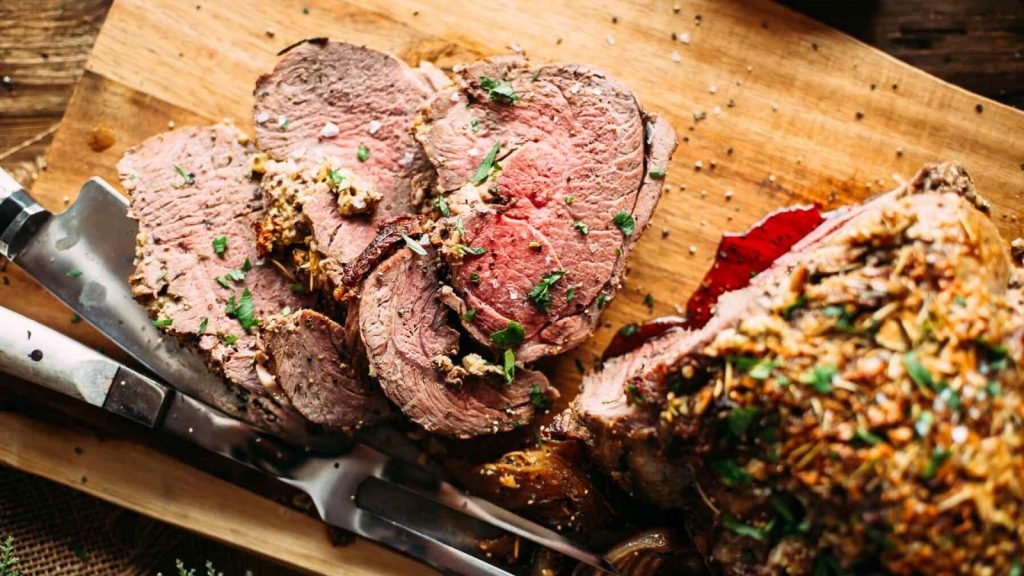Experience a mouthwatering boneless leg of lamb, stuffed with roasted garlic and adorned with a fragrant herb crust. This recipe ensures that every bite is filled with rich flavor, while the pan sauce is so good, you’ll want to sip it straight! Perfect for special gatherings or unforgettable family dinners, this lamb roast will be the star of your table.
Budget Information
The total cost of this boneless leg of lamb recipe is approximately $45.50, making it about $5.68 per serving if you slice it into 8 hearty portions. Here’s a quick breakdown of the cost:
Boneless leg of lamb (4 lbs): $30.00
Garlic (20 cloves): $1.00
Herbs & Spices: $5.00
Mustard: $0.75
Onions (2): $1.00
White wine: $3.00
Chicken broth: $2.00
Why This Recipe Works
This recipe stands out because it combines the rich flavors of garlic and herbs directly with the meat, creating a dish that bursts with taste in every bite. By roasting the garlic inside and encrusting the lamb with a blend of mustard and fresh herbs, you ensure a deep, aromatic flavor that’s perfectly balanced. Plus, the pan sauce made from drippings offers a savory finish that’ll complement the moist lamb beautifully. You’ll be amazed at how simple it is to create such restaurant-worthy fare right in your own kitchen!
Ingredients + Optional Substitutions
Here’s what you’ll need for this fantastic recipe:
- 4 lbs boneless leg of lamb: If you can’t find it pre-boned, ask your butcher to prepare it for you. (Approx. $30.00)
- 15-20 cloves of garlic, minced: Adding a whole head for roasting gives an amazing flavor. (Approx. $1.00)
- Fresh herbs: Use rosemary and thyme; dried herbs can be substituted in a pinch. (Approx. $5.00)
- Dijon mustard: This adds complexity; yellow mustard is a fine alternative. (Approx. $0.75)
- Kosher salt and freshly ground black pepper: To taste; no substitutes here!
- 2 onions: Sweet or yellow onions work best. (Approx. $1.00)
- White wine: Any dry white wine will do, or use extra chicken broth for a non-alcoholic version. (Approx. $3.00)
- Chicken broth: Homemade or store-bought, it’s vital for the pan sauce. (Approx. $2.00)
- Cornstarch: For thickening the sauce; you can use flour as an alternative.
Step-by-Step Recipe Instructions
Step 1: Start by removing the boneless leg of lamb from packaging and pat it dry with paper towels. This important step helps achieve that glorious sear. While the lamb is drying, mix minced garlic with some avocado oil and a pinch of salt to create a smooth paste. This fragrant garlic paste is your first layer of flavor, so rub it generously all over the lamb, ensuring every nook and cranny is covered. Once well-coated, roll the lamb tightly and tie it securely with butcher’s twine in 2-inch intervals. This helps retain its shape and ensures even cooking.
Step 2: Prepare the herb coating by mixing Dijon mustard, chopped rosemary, thyme, garlic powder, onion powder, and some salt and pepper in a bowl. With your hands, rub this aromatic mix over the entire surface of the lamb, creating a beautiful crust that will enhance both the aroma and taste as the lamb roasts.
Step 3: Preheat your oven to 400°F (200°C) and set your roasting pan on the middle-low rack. To set the stage for roasting, place halved lemons, onion wedges, and crushed garlic (still in its skin) in the pan, layering in fragrant herbs, and pour a splash of white wine over the top. Placing the herb-coated lamb directly on top of this aromatic bed will infuse it with flavor while keeping it moist.
Step 4: Roast the lamb in the oven until it reaches an internal temperature of 130°F (about 1-1.5 hours for medium-rare). Check the temperature regularly after the first hour, every 15 minutes thereafter. As they say, it’s better to be patient than risk overcooking!
Step 5: Once that tantalizing aroma fills your kitchen and the lamb has reached its desired temperature, remove it from the oven and let it rest on a cutting board tented with foil for about 15 minutes. This resting period allows juices to redistribute within the meat for a juicier end product.
Step 6: While the lamb rests, transfer the drippings from the roasting pan to the stovetop over medium heat. Discard any solids such as herbs and garlic skins, then deglaze the pan with a bit more white wine, scraping up those glorious browned bits. Squeeze in a couple of roasted garlic cloves, mix cornstarch with broth in a separate bowl to form a slurry, and add this to the pan along with remaining broth. Let this simmer until thickened for a fantastic pan sauce, seasoning with salt, pepper, and a splash of fresh lemon juice for brightness.
Step 7: With the lamb rested, carefully remove the twine and slice it into 1/4-inch thick slices against the grain. Serving it this way ensures maximum tenderness. On a serving platter, daintily arrange lamb slices alongside roasted onion wedges, drizzling the delightful pan sauce generously over the top, creating a presentation that will have everyone eagerly anticipating dinner time!
Nutritional Facts
The following nutritional information is an estimate per serving:
- Calories: 243 kcal
- Protein: 31 g
- Carbohydrates: 7 g
- Total Fats: 9 g
- Saturated Fat: 2 g
- Fiber: 1 g
- Sugar: 2 g
- Sodium: 1135 mg
Storage and Reheating Tips
Once you’ve savored your delicious lamb, store leftovers in an airtight container in the refrigerator for up to 4 days. When you’re ready to enjoy it again, gently reheat the lamb in an oven preheated to 275°F, placing it in a covered dish with a splash of the reserved sauce or chicken broth to keep it moist. This approach ensures that your delicious roast remains juicy and retains its flavor.
Serving Suggestions
This roasted boneless leg of lamb pairs beautifully with a variety of sides! Consider serving it with:
- Roasted root vegetables: Carrots, parsnips, and potatoes drizzled with olive oil and sprinkled with salt make a delightful accompaniment.
- Crisp green salad: A fresh salad with arugula, cherry tomatoes, and a light vinaigrette balances the richness of the lamb.
- Garlic mashed potatoes: Creamy and buttery mashed potatoes enhance every flavorful bite of lamb.
Reader Tips or Helpful Notes
Take your time when roasting the lamb and remember to trust your meat thermometer—it’s the best way to ensure perfect doneness! Don’t hesitate to experiment with different herbs and spices for the crust based on what you love. If you have any leftovers, use them in sandwiches the next day for a decadent treat that requires zero effort!
Recipe FAQs
Can I use a different cut of lamb for this recipe? Yes, you can use a leg of lamb with the bone in, but cooking times will vary, and it might be a little trickier to slice.
Is it necessary to let the lamb rest before slicing? Absolutely! This allows the juices to redistribute throughout the meat, resulting in a juicier, more flavorful dish.
What if I don’t like garlic? You can reduce the amount of garlic or substitute it with shallots, which provide a sweeter flavor.
Can I prepare this dish ahead of time? You can marinate the lamb with garlic and herbs a day in advance, making the prep super easy on the day of roasting!
What do I do if the lamb is still tough after cooking? If it’s tough, it might need a little more cooking time. Lamb is best at medium-rare, but if you’ve gone beyond that, consider slicing it thinly and serving it with a sauce to enhance tenderness.


